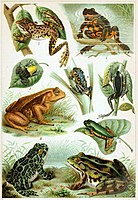
Photo from wikipedia
Winter climate warming is rapidly leading to changes in snow depth and soil temperatures across mid- and high-latitude ecosystems, with important implications for survival and distribution of species that overwinter… Click to show full abstract
Winter climate warming is rapidly leading to changes in snow depth and soil temperatures across mid- and high-latitude ecosystems, with important implications for survival and distribution of species that overwinter beneath the snow. Amphibians are a particularly vulnerable group to winter climate change because of the tight coupling between their body temperature and metabolic rate. Here, we used a mechanistic microclimate model coupled to an animal biophysics model to predict the spatially-explicit effects of future climate change on the wintering energetics of a freeze-tolerant amphibian, the Wood Frog (Lithobates sylvaticus), across its distributional range in the eastern United States. Our below-the-snow microclimate simulations were driven by dynamically downscaled climate projections from a regional climate model coupled to a one-dimensional model of the Laurentian Great Lakes. We found that warming soil temperatures and decreasing winter length has opposing effects on Wood Frog winter energy requirements, leading to geographically heterogeneous implications for Wood Frogs. While energy expenditures and peak body ice content were predicted to decline in Wood Frogs across most of our study region, we identified an area of heightened energetic risk in the northwestern part of the Great Lakes region where energy requirements were predicted to increase. Because Wood Frogs rely on body stores acquired in fall to fuel winter survival and spring breeding, increased winter energy requirements have the potential to impact local survival and reproduction. Given the geographically variable and intertwined drivers of future under-snow conditions (e.g. declining snow depths, rising air temperatures, shortening winters), spatially-explicit assessments of species energetics and risk will be important to understanding the vulnerability of subnivium-adapted species.
Journal Title: Global change biology
Year Published: 2020
Link to full text (if available)
Share on Social Media: Sign Up to like & get
recommendations!